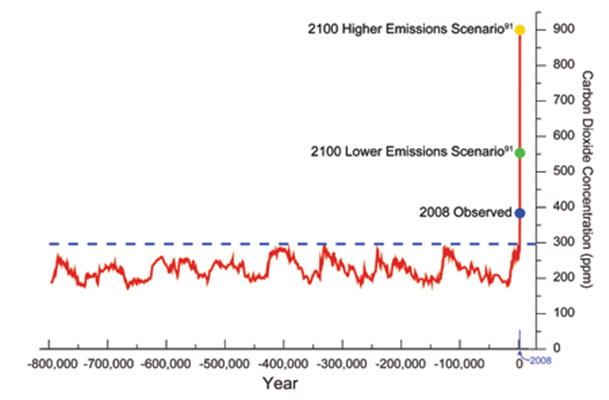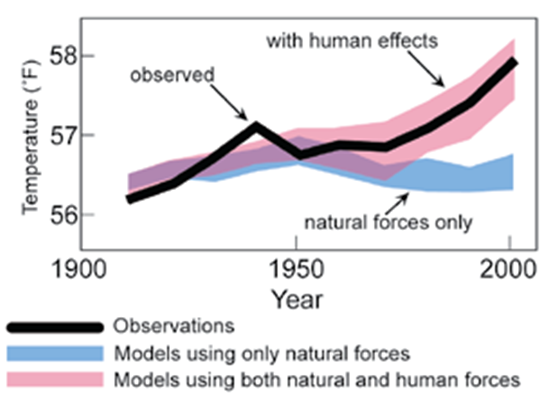The urgency of climate mitigation, the Supreme Court’s mandate, and the legal attacks:
According to the insurance company Munich Re, there have been 98 natural disasters in the United States the first six months of 2011 – approximately double the average of the 1990s. Ten of those disasters have been catastrophes causing more than a billion dollars of damage, including two major river floods in the Upper Midwest and the Mississippi River, drought and wildfires in the Southwest, a blizzard that paralyzed the Midwest and Northeast, and Hurricane Irene which threatened the coastal cities of the East Coast and led to the devastating flooding in the Northeast. More intense storms – including hurricanes – and more frequent and severe floods and droughts, are precisely the kind of impacts expected to threaten American communities as atmospheric greenhouse gas concentrations rise. Although we cannot connect any individual hurricane or wildfire to climate change, we can look around and see what the future holds if we do not act to curb climate-destabilizing emissions.
In 2007, the Supreme Court held in Massachusetts v. EPA that greenhouse gases are “air pollutants” under the Clean Air Act and that EPA had a legal duty to decide whether greenhouse gas emissions endanger public health or welfare. The Supreme Court also held that under the Clean Air Act, the endangerment inquiry must be based solely on science, and not on policy considerations irrelevant to this “scientific judgment.”
In response to the Supreme Court’s mandate, and based on the massive edifice of research showing the role of anthropogenic greenhouse gas emissions in causing global temperatures to rise and related climate impacts to occur, EPA took action under the Clean Air Act. In 2009 EPA made the science-based finding that greenhouse gas emissions endanger public health and welfare – the “Endangerment Finding.” Once EPA has made an endangerment finding for an air pollutant emitted by motor vehicles, the Clean Air Act obligates EPA to establish vehicle emission standards. On April 1, 2010, EPA finalized standards for MY 2012-2016 light-duty vehicles. The standards are projected to avoid 962 million metric tons of CO2-equivalent, cut gasoline consumption by 77 billion gallons, and save vehicle owners a net average of $3,000 over the life of the vehicle due to enhanced fuel economy.
The Endangerment Finding is under legal attack from some of the largest polluters in America. The legal challenges to the Endangerment Finding, vehicle standards, and the other actions EPA has taken to control greenhouse gas emissions are currently before the U.S. Court of Appeals in Washington D.C.
The basis for the GHG Endangerment Finding:
EPA’s Endangerment Finding is based on a rigorous review of climate change research – including assessments of climate research prepared by the National Research Council of the National Academy of Sciences, the United States Global Change Research Program, and the Intergovernmental Panel on Climate Change. The creation of these “assessment reports” involved thousands of scientists, reviewing thousands of articles from peer-reviewed research journals. Based on this massive body of research, EPA determined the following:
- Human activities – fossil fuels burning and land use change – have changed the chemistry of the atmosphere, adding tremendous quantities of heat-trapping gases. The concentration of carbon dioxide in the atmosphere has increased by 38% since the Industrial Revolution; concentrations of methane have risen 149%.

This chart shows CO2 concentrations in the atmosphere over the last 800,000 years, based upon analyzing air bubbles trapped in an Antarctic ice core. (U.S. Global Change Research Program, Global Climate Change Impacts in the United States at 13 (2009))
- Temperature records show that average global temperatures are rising – and scientists have concluded that the warming of the past 40 years has been driven by the increasing concentrations of greenhouse gases, “trapping” more and more radiation from the sun in Earth’s atmosphere.

This figure shows that climate models using only natural forces cannot replicate observed warming – in fact, they would predict cooling. Only models including anthropogenic greenhouse gases can duplicate the observed warming trend. (U.S. Global Change Research Program, Global Climate Change Impacts in the United States at 20 (2009).)
- The effects of this warming are already being observed, and are expected to intensify in the future as the climate continues to warm. The U.S. Global Change Research Program describes the following climate change impacts as “likely,” having at least a two-thirds chance of afflicting Americans: stronger hurricanes and storm surges; more intense rainfall events; declines in precipitation and runoff in the West; increased frequency and severity of both floods and droughts; increased risk of illness and death due to extreme heat and heat waves; increased air pollution in cities that causes respiratory distress; and increases in the prevalence of diseases transmitted by food, water, and insects.
- Reducing greenhouse gas emissions will reduce the severity of these impacts. Reducing emissions will also lower the risk of pushing the dynamic climate system past a “threshold” that would lead to dramatic, abrupt climate changes with potentially catastrophic impacts for human societies and natural systems.
Based on this body of research, EPA determined that greenhouse gas emissions endanger the public health and welfare.
The legal attacks and the Supreme Court’s directive:
In attacking the Endangerment Finding, the legal challenges make a wide variety of claims – including arguing that the areas of uncertainty in climate science should prevent EPA from finding that greenhouse gas emissions endanger public health or welfare, that EPA was wrong to rely on the scientific assessments, and that EPA needed to consider various policy considerations before making the Endangerment Finding.
A little bit of history those attacking the Endangerment Finding seem to have forgotten: As noted above, in 2007 the Supreme Court held that EPA had a duty to make a “scientific judgment,” and that “considerations that have nothing to do with whether greenhouse gas emissions contribute to climate change” have no place in an endangerment analysis. The Court further held that EPA could only decline to make a scientific judgment if the uncertainty “is so profound that it precludes EPA from making a reasoned judgment as to whether greenhouse gases contribute to global warming.”
States and environmental groups supporting EPA:
Last Friday, September 16th, sixteen States and a coalition of environmental groups – including EDF – filed a brief supporting EPA’s Endangerment Finding. The States supporting EPA’s science-based Endangerment Finding are California, Connecticut, Delaware, Illinois, Iowa, Massachusetts, Maine, Maryland, Minnesota, New Hampshire, New Mexico, New York, Rhode Island, Oregon, Vermont, and Washington. The brief and more information about the litigation are available here.
Oral argument for the Endangerment Finding challenge and the related cases will likely be scheduled early in 2012. We will let you know of any developments as they occur.












